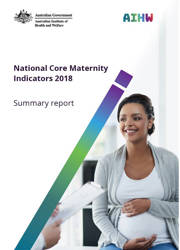National Core Maternity Indicators 2018: summary report
Citation
AIHW
Australian Institute of Health and Welfare (2020) National Core Maternity Indicators 2018: summary report, AIHW, Australian Government, accessed 25 April 2024. doi:10.25816/pn5g-0634
APA
Australian Institute of Health and Welfare. (2020). National Core Maternity Indicators 2018: summary report. Canberra: AIHW. doi:10.25816/pn5g-0634
MLA
Australian Institute of Health and Welfare. National Core Maternity Indicators 2018: summary report. AIHW, 2020. doi:10.25816/pn5g-0634
Vancouver
Australian Institute of Health and Welfare. National Core Maternity Indicators 2018: summary report. Canberra: AIHW; 2020. doi:10.25816/pn5g-0634
Harvard
Australian Institute of Health and Welfare 2020, National Core Maternity Indicators 2018: summary report, AIHW, Canberra. doi:10.25816/pn5g-0634
PDF | 1.6Mb
The National Core Maternity Indicators (NCMIs) present information on measures of clinical activity and outcomes to assist in improving the quality of maternity services in Australia by establishing baseline data for monitoring and evaluating practice change. These indicators cover data for the majority of women who gave birth in Australia from 2004 to 2018 and are grouped into 3 broad topic areas—antenatal period, labour and birth and birth outcomes.
This summary report is designed to accompany National Core Maternity Indicators 2018.
- ISBN: 978-1-76054-760-8
- DOI: 10.25816/pn5g-0634
- Cat. no: PER 109
- Pages: 20
-
1 in 10 (9.2%) women smoked during the first 20 weeks of pregnancy in 2018
-
In 2018, 30% of selected women giving birth for the first time had a caesarean section
-
Women younger than 20 years were least likely to access antenatal care in the first trimester
-
1 in 5 (22%) women having their first baby vaginally without instruments had an episiotomy in 2018



